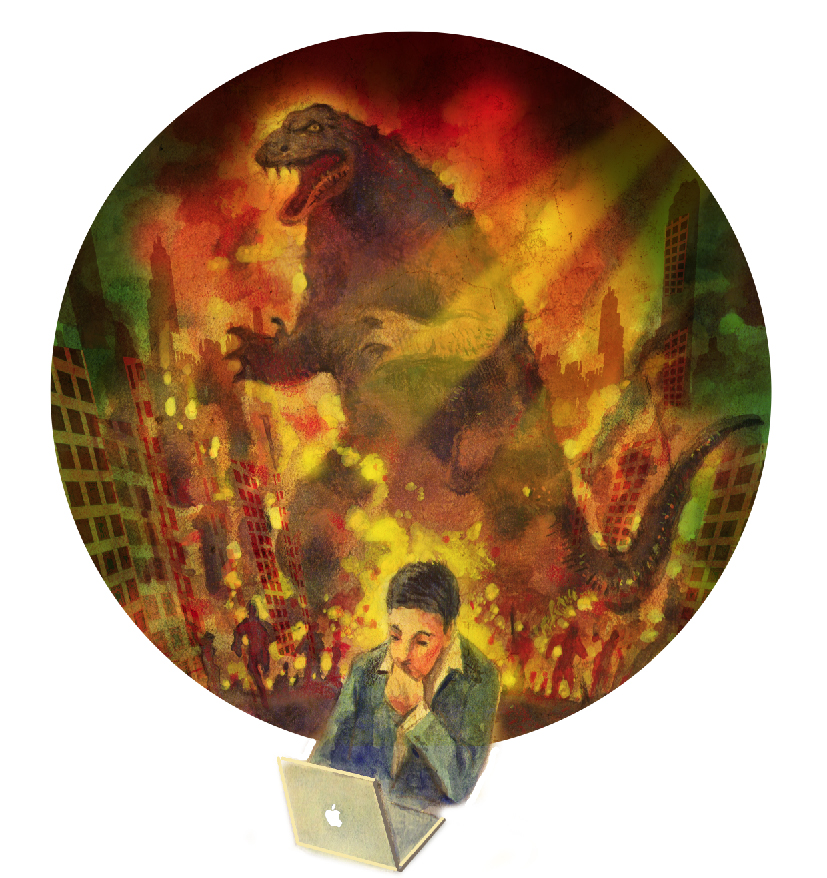The following is a blog by Kate Tallent, of KTD Creative.
Have you ever had a run-in with Godzilla? This has happened to me on occasion. Recently I was meeting with a client, asking questions that would form the basis for a new web site design. An hour into the discussion the client stated that the questions seemed tedious and that he did not know why his project would entail so much research and preparation for what was merely a “site refreshment.”
I replied that he had contracted my firm to produce a new site, not a “refreshment,” at which point the client became Godzilla. He roared. He got angry. According to Wikipedia, “the most notable of Godzilla’s … abilities is his atomic breath: a powerful heat ray of fire from his mouth.” Cue special effects. I was feeling the heat ray. Ouch.
Frustrated, Godzilla jumped up and ran to his computer, where he tried to find emails about a “web site refreshment.” Instead he found a proposal, contract and questionnaires his staff had completed that were used to form a creative brief — also among the emails.
The paper trail was there. Godzilla backed down. Returned to his human form, the client and I resumed a discussion about the new site. We reviewed the creative brief together.
I should mention that I like this smart, committed client a great deal. But he juggles many projects and manages a large staff. The afternoon of the meeting, he was having a terrible day. Having them myself, I can relate. But the paper trail saved designer face. Had I not had the creative brief, as well as the contract and proposal, this busy CEO might have dismissed my firm. As it was, he and I reviewed the creative brief, and he added items for consideration. The project could get started.
The creative brief has that power. It ensures that you and the client are on the same page — and therefore stops any Godzilla eruptions in their tracks. So what is a creative brief, and why do you need one after you have the necessary proposal and contract?
The creative brief provides strategic direction for a project. It documents the key insights gained from the designer’s meetings with clients and the research phase.
The creative brief must be done before a designer rolls up her sleeves and sketches or jumps on a computer. In the case of a logo, for example, the brief directs the development of a new brand identity. It guides the designer. It is analogous to a word list that must be done before creating any logo.
Creative briefs can be many pages long but must include five elements: an overview of the organization; identification of target audience/s; identification of competing brands; positioning statement; and organizational personality.
1. Overview of the organization. The overview details the client’s mission, in the case of a nonprofit or agency, or product, in the case of a business. It details why the projects in the contract are desirable for the client. For example, you might state that an organization needs a cohesive identity. You acknowledge that the client understands the value that can be added to any organization by coordinating logos, color schemes, naming and taglines. You might continue and state that a new, more cohesive identity can then be translated through a web site and any marketing materials.
2. A target audience or audiences will be clarified. Audience identification is critical. For example, let’s imagine a client — we’ll call it the Maryland Medical Outreach Center. This nonprofit has two primary target audiences: the funders who support the services and the clients who use them. Other important audiences are the community around the center; insurance companies; and media that can influence funders and spread the word to potential clients.
For the purposes of achieving Maryland Medical Outreach Center’s goal of increasing financial strength, funders (including government officials) are the primary audience for a new brand identity — and therefore for the brief.
3. Competing brands will be identified and reviewed. Peers’ branding must be reviewed to ensure that designs created for the client are not too similar to their peers’ look.
4. A statement about positioning will outline the client’s role, especially in relation to its peers. Here is an example: For government, foundation and corporate donors concerned about access to health care services for low-income people, Maryland Medical Outreach Center is the only organization that offers a comprehensive, state-wide approach to solving clients’ health care problems, so they can give to one organization and be assured that they will have the greatest impact for low-income Marylanders in need.
5. The organizational personality equates a complex organization to a human being — making the organization easier to understand and the designer’s job easier.
For example: If Maryland Medical Outreach Center were a person, she/he would be a smart, hardworking professional with a passion for social justice, health care and equity. She/he would be a caretaker and nurturer by nature and a winner through skill and experience. She/he would be willing to fight battles and produce results.
A few other points might be mentioned in the brief, such as essential aspect; supporting points; and tone and feel.
The client will review the creative brief to ensure it accurately sums up the five elements. Without the client’s blessing on the creative brief (as well as a proposal and signed contract), a designer should not proceed with the project.
Once you have client approval, you’ve eliminated any opportunities for Godzilla to present himself. And you can get to work.
Read and learn more at KTD Creative.


